AMD Zen 4 Ryzen 9 7950X and Ryzen 5 7600X Review: Retaking The High-End
by Ryan Smith & Gavin Bonshor on September 26, 2022 9:00 AM ESTCPU Benchmark Performance: Simulation And Encoding
Simulation and Science have a lot of overlap in the benchmarking world, however for this distinction we’re separating into two segments mostly based on the utility of the resulting data. The benchmarks that fall under Science have a distinct use for the data they output – in our Simulation section, these act more like synthetics but at some level are still trying to simulate a given environment.
One of the interesting elements on modern processors is encoding performance. This covers two main areas: encryption/decryption for secure data transfer, and video transcoding from one video format to another.
In the encrypt/decrypt scenario, how data is transferred and by what mechanism is pertinent to on-the-fly encryption of sensitive data - a process by which more modern devices are leaning to for software security.
Video transcoding as a tool to adjust the quality, file size and resolution of a video file has boomed in recent years, such as providing the optimum video for devices before consumption, or for game streamers who are wanting to upload the output from their video camera in real-time. As we move into live 3D video, this task will only get more strenuous, and it turns out that the performance of certain algorithms is a function of the input/output of the content.
We are using DDR5 memory on the Ryzen 9 7950X and Ryzen 5 7600X, as well as Intel's 12th Gen (Alder Lake) processors at the following settings:
- DDR5-5200 CL44 - Ryzen 7000
- DDR5-4800 (B) CL40 - Intel 12th Gen
All other CPUs such as Ryzen 5000 and 3000 were tested at the relevant JEDEC settings as per the processor's individual memory support with DDR4.
Simulation
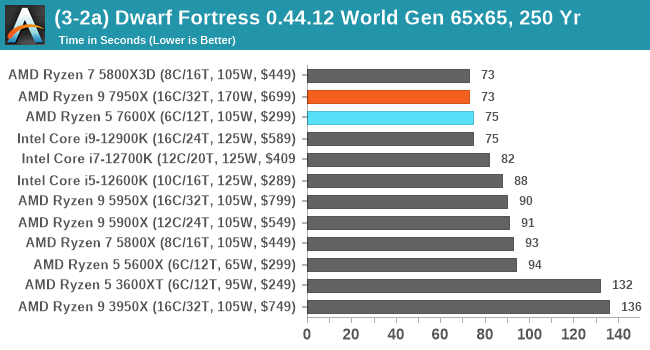
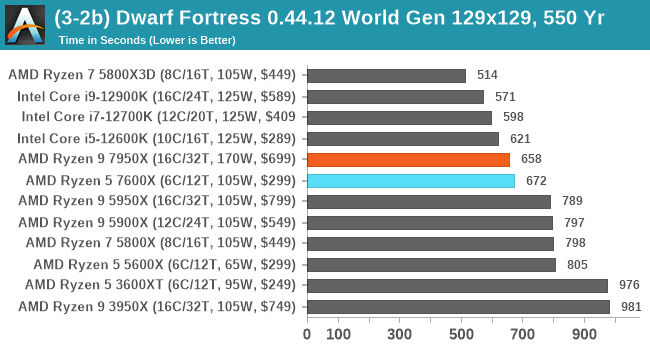
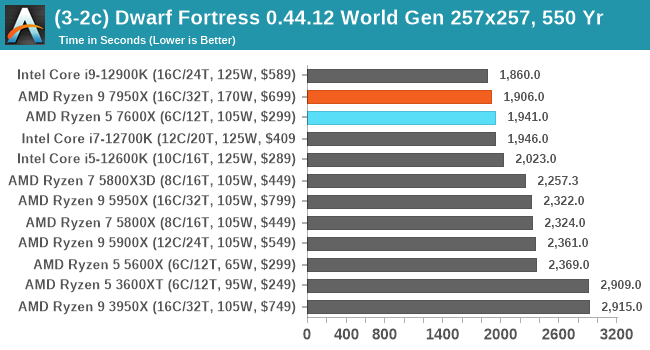
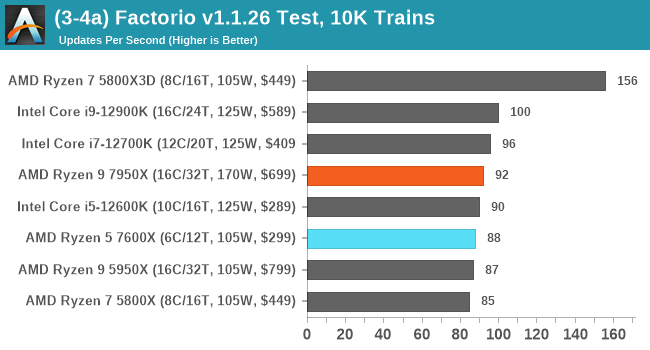
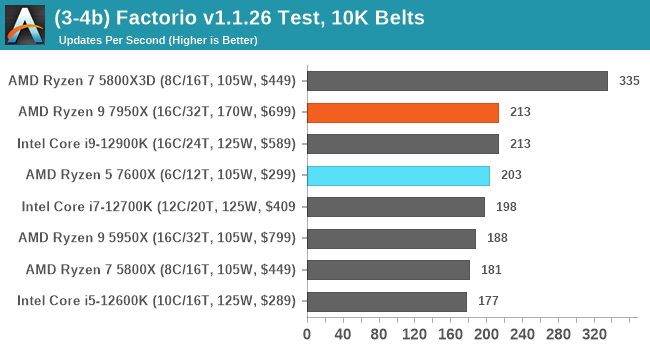
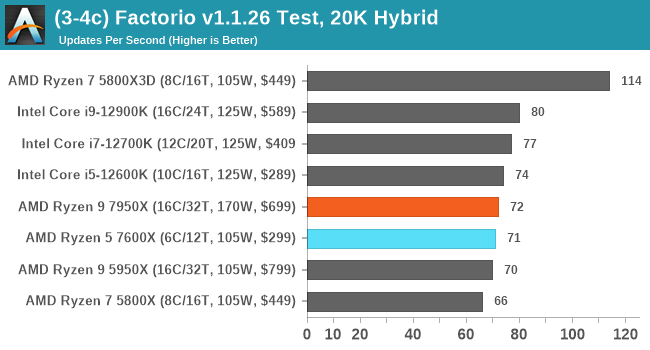
Starting with the Dwarf Fortress section of our simulation suite, the performance of the Ryzen 9 7950X and Ryzen 5 7600X is inconsistent, to say the least. In the smaller of our three Dwart Fortress tests, there's around 2-3% difference between the Ryzen 7000 chips, the Core i9-12900K and Core i7-12700K, and AMD's impressive Ryzen 7 5800X3D with its incredibly large 96 MB pool of cache to play with.
In the larger Dwarf Fortress workloads, and the Alder Lake based Core i9-12900K, the Core i7-12700K and the Core i5-12600K show better scope for performance, with the exception being the Ryzen 7 5800X3D which due to its large 3D V-Cache, keeps the pressure on Intel.
Looking at performance in our Factorio benchmarks, the AMD Ryzen 7 5800X3D with its 3D V-Cache is streets ahead of the competition, with both the Ryzen 9 7950X and Ryzen 5 7600X both lagging behind considerably. Comparing Ryzen 7000 to Intel's Alder Lake, Alder Lake has the overall advantage here, even with the many optimizations and improvements that Zen 4 brings to the table.
Encoding
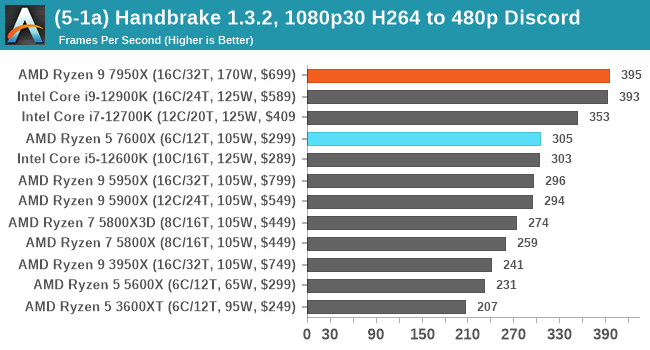
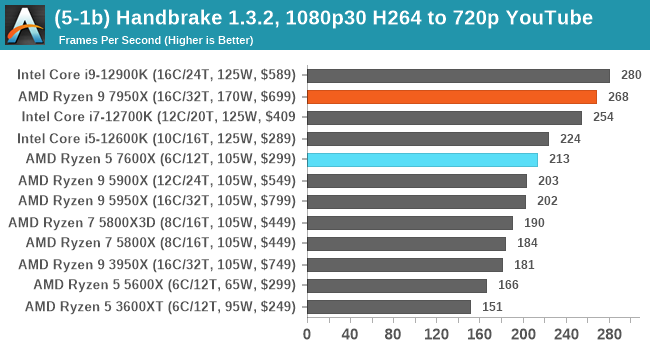
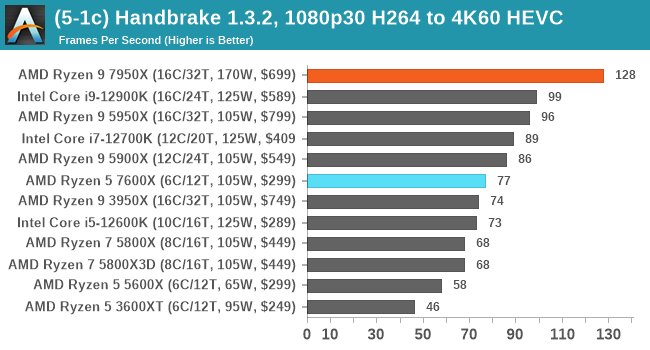
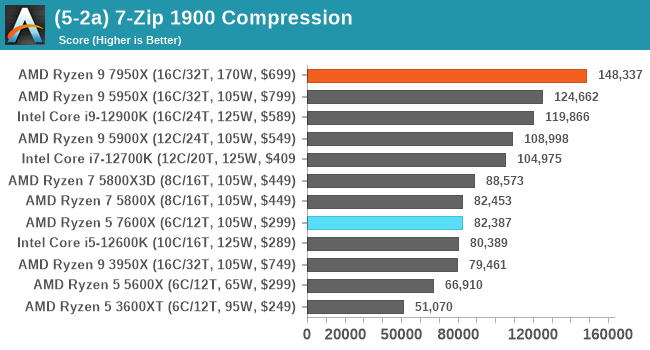
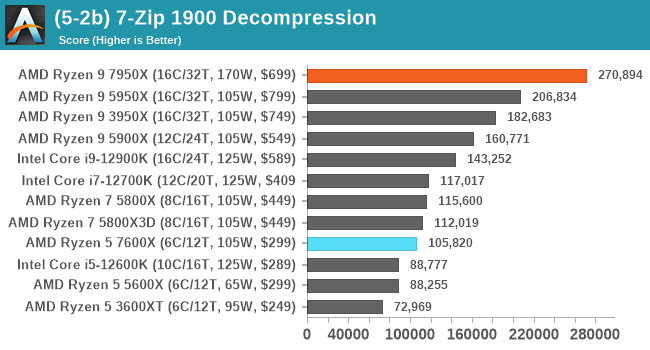
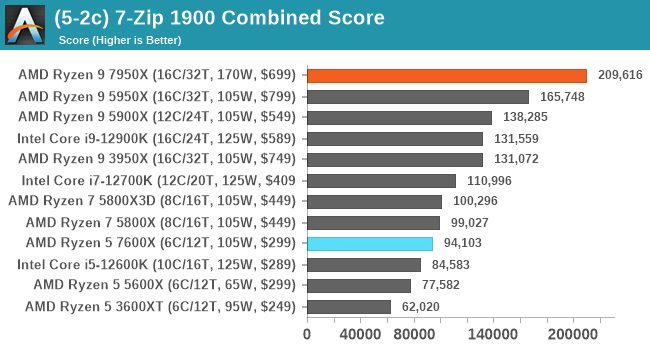
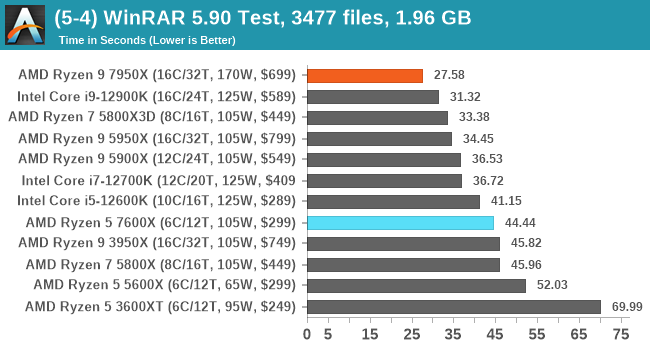
Focusing on encoding, and the Ryzen 9 7950X is the clear winner, beating the Core i9-12900K in all but one of the Handbrake tests (1080p30). The Ryzen 5 7600X trades blows with last generation Ryzen 7 5800X, which is an improvement within itself, as the Ryzen 5 5600X does lag behind the rest of the pack.










205 Comments
View All Comments
RestChem - Wednesday, October 5, 2022 - link
Meh, time will out the ultimate price-points and all that, but as it emerges I really wonder what kind of users are looking to drop this kind of dollarses on high-end AMD builds. My gut is that they've priced themselves out of their primary demographic, and max TDP is right up there too, same as with their GPUs. When it comes down to a difference of a couple hundred bucks per build (assuming people build these with the pricey DDR5-6000 there's scant mobo support for through whatever AMD's integrated mem-OC profile scheme is) are there going to be enough users who just root hard enough for the underdog to build on these platforms, contra even high-end Alder Lake or (however much extra, reamins at time of writing to be seen) Raptor Lake builds? Before the announcements I was expecting AMD to get in cheap again, promise at least like performance for a bit of a discount, but it seems even those days are over and they want to play head-to-head. I wish them the best but I don't see them scoring well in that fight. Replytvdang7 - Thursday, October 6, 2022 - link
" I have a 1440p 144Hz monitor and I play at 1080p just because that's what I'm used to."Is this some kind of joke. We are supposed to listen to reviewers that are stuck in 2010 Reply
Hresna - Sunday, October 9, 2022 - link
I’m curious as to whether there’s any appreciable difference to a consumer as to whether a particular PCIe lane or USB port is provisioned by the CPU or the Chipset…. Like, is there a reliability, performance, or some other metric difference?I’m just curious why it’s a design consideration to even include them in the CPU design to begin with, unless it has to do with how the CPU lanes are multiplexed in/out of the CPU and somehow some of the lanes can talk inter-device via the chipset without involving the cpu… Reply
bigtree - Monday, October 10, 2022 - link
Where is octa channel memory? dual channel memory is a $300 CPU.Where is native Thunderbolt 4 support?
(mac minis have had thunderbolt 3 for over 5 years).
Cant even find one X670 Motherboard with 4x Thunderbolt 4 ports. And you want $300? Thunderbolt 4 should be standard on the cheapest boards. Its a $20 chip. Reply
Oxford Guy - Monday, October 10, 2022 - link
The mission of corporations is to extract profit for shareholders and protect the lavish lifestyles of the rich. It is not to provide value to the plebs. Do the absolute minimum is the mantra. ReplyRedGreenBlue - Tuesday, October 11, 2022 - link
That must be why Intel made Thunderbolt royalty-free and it’s now built into USB 4. ReplyOxford Guy - Wednesday, October 12, 2022 - link
It probably can afford to since states like Ohio are willing to bankroll half of the cost of its fabs. ReplyRedGreenBlue - Tuesday, October 11, 2022 - link
It’s built into USB 4 now. Just make sure it’s functional already because it might need a driver, AMD did that on the 600 series. Aside from that important fact, I don’t care if there aren't many boards with it. The thunderbolt ecosystem has been crap since the beginning. Peripheral makers didn’t take advantage of it because USB was a more common approach and intel didn’t make thunderbolt cheap to implement. The Mac Minis have it because Apple made a big bet on it when it came out. These days it’s nice to have but it’s a throw-away feature unless you have a niche product that needs it. It’s for niche purposes and that would have been a waste of pci lanes. I would’ve liked it for external GPU’s but intel effectively shut that down and I don’t know if they’ve opened the door to it again. USB is way more convenient. ReplyRedGreenBlue - Tuesday, October 11, 2022 - link
And 8 channel memory, like, this sounds like a joke. That’s for server or workstation cpus because of how many layers it takes for the wiring on the board and the pins on the socket. That’s part of why server and workstation boards are so expensive. If you need that much bandwidth you’re in the wrong market segment. Look at Threadripper chips. ReplyRedGreenBlue - Tuesday, October 11, 2022 - link
It would be appreciated if architecture reviews had the pipeline differences in a chart to compare across generations. Anandtech used to have that included and it gave a good comparison of different generations and competitor architectures. I can understand not including it in the product review but I don’t remember a chart being in the previous Zen 4 overview article. Reply